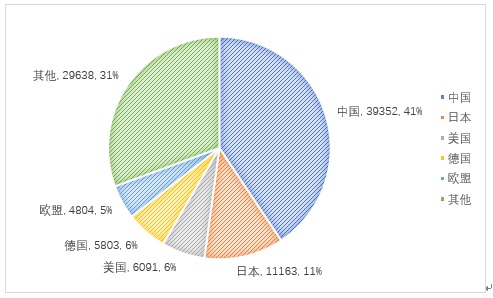 PDF(832 KB)
PDF(832 KB)


Research on the Contribution of the Number of Patent Families to the Value of Patents——Taking Solar Energy as An Example
Long Yixuan, Wang Xiaomei
Knowledge Management Forum ›› 2019, Vol. 4 ›› Issue (1) : 34-41.
 PDF(832 KB)
PDF(832 KB)
 PDF(832 KB)
PDF(832 KB)
Research on the Contribution of the Number of Patent Families to the Value of Patents——Taking Solar Energy as An Example
 ,
,

[Purpose/significance] Research on the contribution of the number of patent families to the value of patents can provide an important reference for patents strategy layout optimization and patent value evaluation. [Methods/process] Taking the new clean solar energy field as an example, we identified high-value and low-value patent data sets, and designed experiments on patent family size differences between high-value patents and low-value patents. Finally, then SPSS 22 was used to verify the model. [Results/conclusion] Empirical research have shown that the contribution of the number of patent families to the value of patents is not invariable. With the continuous expansion of the patent families, the proportion of patent families is no longer significant difference between high-value patents and low-value patents. At this time, the increase in the number of patent families has significantly reduced the contribution to patent value.

patent family / patent value / solar Energy technology / high-value patents / low-value patents
| [1] |
HARHOFF D, SCHERER F M, VOPEL K. Exploring the tail of patented invention value distribution [M]. Boston: Kluner Academic Publishes, 2003.
|
| [2] |
SCHANKERMAN M and PAKES A. The rate of obsolescence and the distribution of patent values - some evidence from European patent renewals[J]. Revue economique, 1985, 36(5): 917-941.
|
| [3] |
PAKES A. Patents as options: some estimates of the value of holding european patent stocks[J]. Econometrica, 1986, 54(4): 755-784.
|
| [4] |
GRILICHESS Z. Patent statistics as economic indicators: a survey[J]. Journal of economic literature, 1990, 28(4): 1661-1707.
|
| [5] |
ZUCKER L G, DARBY M R, BREWER M B. Intellectual human capital and the birth of US technology enterprises[J]. American economic review, 1998, 88(1): 190-306.
|
| [6] |
HARHOFF D, SCHERER F M, VOPEL K, Citations, family size, opposition and the value of patent rights[J]. Research policy, 2003, 32(8):1343-1363.
|
| [7] |
SAPSALIS E. The institutional sources of knowledge and the value of Academic patents[J]. Economics of innovation & new technology, 2007, 16(2): 139-157.
|
| [8] |
GRIMALDI M, CRICELLI L, GIOVANNI M D, et al. The patent portfolio value analysis: A new framework to leverage patent information for strategic technology planning[J]. Technological forecasting and social change, 2015, 94(1): 286-302.
|
| [9] |
LANJOUW J O, SCHANKERMAN M. Patent quality and research productivity: measuring innovation with multiple indicators[J]. Economic journal, 2004, 114(495): 441-465.
|
| [10] |
TRAPPEY A J C, TRAPPEY C V, Wu C Y, et al. A patent quality analysis for innovative technology and product development[J]. Advanced engineering informatics, 2012, 26(1): 26-34.
|
| [11] |
WU J L, CHANG P C, TSAO C C, et al. A patent quality analysis and classification system using self-organizing maps with support vector machine[J]. Applied soft computing, 2016, 41(C): 305-316.
|
| [12] |
ZHANG Y, QIAN Y, HUANG Y, et al. An entropy-based indicator system for measuring the potential of patents in technological innovation: rejecting moderation[J]. Scientometrics, 2017, 111(3): 1925-1946.
|
| [13] |
GUELLEC D. Applications, grants and the value of patent[J]. Economics letters, 2000, 69(1): 109-114.
|
| [14] |
ALLISON J R, LEMLEY M, MOORE K, et al. Valuable patents[J]. Georgetown law journal, 2004, 92(3): 435-479.
|
| [15] |
ALLISON J R, SAGER T W. Valuable patents redux: on the enduring merit of using patent characteristics to identify valuable patents[J]. Texas law review, 2007, 85(7): 1769-1797.
|
| [16] |
张克群, 李姗姗, 郝娟. 不同技术发展阶段的专利价值影响因素分析[J]. 科学学与科学技术管理, 2017, 38(3): 23-29.
|
| [17] |
郭秋萍, 赵静, 朱明珠. 专利与技术标准融合的陷阱及其规避[J]. 情报杂志, 2014, 33(9): 40-44.
|
龙艺璇:进行数据收集,实验设计,论文撰写与修订;
王小梅:提出研究选题,修订论文。
/
| 〈 |
|
〉 |